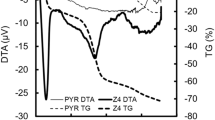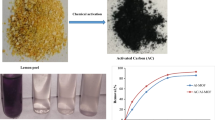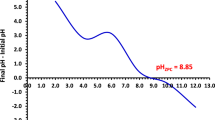Abstract
The level of tungstate in freshwater is disturbing due to its toxicity and its impact to human health. Thus, the current study explores the use of Ag nanoparticle (AgNP)–treated activated carbon (AgNPs/AC) nanocomposite as solid phase extractor (SPE) for removal of trace levels of tungstate ions in water. The AgNPs/AC was synthesized by chemical binding of Ag nanoparticles onto AC. The microstructure image indicated that the AgNPs were uniformly dispersed on AC surface and thus maintaining high surface area. Scanning electron micrographs of AgNPs/AC revealed a three-dimensional structure which is suitable as SPE. The AgNPs/AC nanocomposite was used as a low-cost and effective SPE for tungstate removal from water. Adsorption of tungstate from aqueous media reached maximum at pH ≈ 4 and reached equilibrium in < 20 min. Tungstate sorption followed pseudo-second-order kinetic with an overall rate constant (k) of 0.72 min.−1 The negative values of ΔH and ΔG are interpreted as exothermic and spontaneous reaction of tungstate sorption by the adsorbent, respectively. The positive value of ΔS (R2 = 0.999) reflected good absorption and/or adsorption of the oxyanion [WO4]2− as an ion associate with the bulky cations and the surface area available in the nanocomposite. The sorbent AgNPs/AC was also packed column for preconcentration of trace levels of tungstate in tap water samples. Tungstate species were satisfactorily recovered with NaOH (1.0 mol L−1) and subsequently ICP-OES analyzed.











Similar content being viewed by others
References
Acevedo, S., Arevalo-Fester, J., Galicia, L., Atencio, R., Plaza, E., & Gonzalez, E. (2014). Efficiency study of silver nanoparticles (AgNPs) supported on granular activated carbon against Escherichia coli. Journal of Nanomedicine Research, 1, 00009.
Adusumalli, V. N. K. B., Runowski, M., Lis, S. (2020). 3,5-Dihydroxy benzoic acid-capped CaF2:Tb3+ nanocrystals as luminescent probes for the WO42− ion in aqueous solution, cite ACs Omega. https://doi.org/10.1021/acsomega.9b03956
Afkhami, A., & Norooz-Asl, R. (2009). Removal, preconcentration and determination of Mo(VI) from water and wastewater samples using maghemite nanoparticles. Colloids and Surfaces A: Physicochemical and Engineering Aspects, 346, 52–57.
Afkhami, A., Madrakian, T., & Amini, A. (2009). Mo (VI) and W (VI) removal from water samples by acid-treated high area carbon cloth. Desalination, 243, 258–264.
Ali, I. (2012). New generation adsorbents for water treatment. Chemical Reviews, 112, 5073–5091.
Almeida, J., Craveiro, R., Faria, P., Silva, A. S., Mateus, E. P., Barreiros, S., Paiva, A., & Ribeiro, A. B. (2020). Electrodialytic removal of tungsten and arsenic from secondary mine resources—deep eutectic solvents enhancement. Science of the Total Environment, 710(1–9), 136364.
Al-Qodah, Z., & Shawabkah, R. (2009). Production and characterization of granular activated carbon from activated sludge. Brazilian Journal of Chemical Engineering, 26, 127–136.
Bazel, Y., Lešková, M., Rečlo, M., Šandrejová, J., Simon, A., Fizer, M., & Sidey, V. (2018). Structural and spectrophotometric characterization of 2-[4-(dimethylamino) styryl]-1-ethylquinolinium iodide as a reagent for sequential injection determination of tungsten. Spectrochimica Acta Part A: Molecular and Biomolecular Spectroscopy, 196, 398–405.
Bednar, A., Mirecki, J., Inouye, L., Winfield, L., Larson, S., & Ringelberg, D. (2007). The determination of tungsten, molybdenum, and phosphorus oxyanions by high performance liquid chromatography inductively coupled plasma mass spectrometery. Talanta, 72, 1828–1832.
Cao, Y., Guo, Q., Shu, Z., Jiao, C., Luo, L., Guo, W., Zhao, Q., & Yin, Z. (2019). Tungstate removal from aqueous solution by nanocrystalline iowaite: an iron-bearing layered double hydroxide. Environmental Pollution, 247, 118–127.
Datta, S., Vero, S. E., Hettiarachchi, G. M., & Johannesson, K. (2017). Tungsten contamination of soils and sediments: current state of science. Current pollution reports, 3, 55–64.
El-Aassar, A. H. M., Said, M. M., Abdel-Gawad, A. M., Shawky, H. A. (2013). Using silver nanoparticles coated on activated carbon granules in columns for microbiological pollutants water disinfection in Abu Rawash area, Great Cairo, Egypt, Australian journal of basic and applied sciences, Australian J Basic Applied Sciences, 7, 422–432.
El-Shahawi, M., & Al Khateeb, L. (2012). Spectrofluorometric determination and chemical speciation of trace concentrations of tungsten species in water using the ion pairing reagent procaine hydrochloride. Talanta, 88, 587–592.
El-Shahawi, M. S., & Nassif, H. A. (2003). Retention and thermodynamic characteristics of mercury(II) complexes onto polyurethane foams. Analytica Chimica Acta, 481, 29–39.
El-Shahawi, M., Othman, M., & Abdel-Fadeel, M. (2005). Kinetics, thermodynamic and chromatographic behaviour of the uranyl ions sorption from aqueous thiocyanate media onto polyurethane foams. Analytica Chimica Acta, 546, 221–228.
Fayazi, M., Afzali, D., Taher, M. A., Mostafavi, A., & Gupta, V. K. (2015). Removal of Safranin dye from aqueous solution using magnetic mesoporous clay: Optimization study. Journal of Molecular Liquids, 212, 675–685.
Ghaedi, M., Heidarpour, S., Kokhdan, S. N., Sahraie, R., Daneshfar, A., & Brazesh, B. (2012). Comparison of silver and palladium nanoparticles loaded on activated carbon for efficient removal of methylene blue: kinetic and isotherm study of removal process. Powder Technology, 228, 18–25.
Gunawardena, J., Ziyath, A. M., Egodawatta, P., Ayoko, G. A., & Goonetilleke, A. (2015). Sources and transport pathways of common heavy metals to urban road surfaces. Ecological Engineering, 77, 98–102.
Hall, G., Jefferson, C., & Michel, F. (1988). Determination of W and Mo in natural spring waters by ICP-AES (inductively coupled plasma atomic emission spectrometry) and ICP-MS (inductively coupled plasma mass spectrometry): application to South Nahanni river area, NWT, Canada. Journal of Geochemical Exploration, 30, 63–84.
Hur, H., & Reeder, R. J. (2016). Tungstate sorption mechanisms on boehmite: Systematic uptake studies and X-ray absorption spectroscopy analysis. Journal of Colloid and Interface Science, 461, 249–260. https://doi.org/10.1016/j.jcis.2015.09.011.
Hussein, F. B., & Abu-Zahra, N. H. (2017). Extended performance analysis of polyurethane–iron oxide nanocomposite for efficient removal of arsenic species from water. Water Science and Technology: Water Supply, 17, 889–896.
Ihsanullah, A., Abbas, A., Al-Amer, M., Laoui, T., Al-Marri Mustafa, M. J., Nasser, M. S., Khraisheh, M., & Atieh, M. A. (2016). Heavy metal removal from aqueous solution by advanced carbon nanotubes: critical review of adsorption applications. Separation and Purification Technology, 157, 141–161.
Ihsanullah, I., Sajid, M., Kabeer, M., Shemsi, A. M., & Atieh, M. A. (2020). First investigations on the removal of tungsten species from water using multi-walled carbon nanotubes. Water, Air, & Soil Pollution, 231, 119–130.
Kavulicová, J., Mražíkováb, A., Velgosová, O., Ivánová, D., & Kubovcíková, M. (2018). Stability of synthesized silver nanoparticles in citrate and mixed gelatinic/citrate solution. Acta Polytechnica, 58(2), 104–108.
Korob, R., Cohen, I., & Agatiello, O. (1976). Tungsten and molybdenum co-precipitation by α-benzoinoxime for activation analysis of tungsten. Journal of Radioanalytical Chemistry, 34, 329–333.
Koutsospyros, A., Strigul, N., Braida, W., & Christodoulatos, C. (2011). Tungsten: Environmental Pollution and Health Effects. Encyclopedia of Environmental Health. https://doi.org/10.1016/B978-0-444-52272-6.00650-4.
Largitte, L., & Pasquier, R. (2016). A review of the kinetics adsorption models and their application to the adsorption of lead by an activated carbon. Chemical Engineering Research and Design, 109, 495–504.
Lee, J., Mahendra, S., & Alvarez, P. J. (2010). Nanomaterials in the construction industry: a review of their applications and environmental health and safety considerations, ACS. ACS Nano, 4, 3580–3590. https://doi.org/10.1021/nn100866w.
Li, S., Deng, N., Zheng, F., & Huang, Y. (2003). Spectrophotometric determination of tungsten (VI) enriched by nanometer-size titanium dioxide in water and sediment. Talanta, 60, 1097–1104.
Li, B., Liu, X., Zhang, X., Zou, J., Chai, W., & Xu, J. (2015). Oil-absorbent polyurethane sponge coated with KH-570-modified graphene. Journal of Applied Polymer Science, 132.
Li, M., Xi, X., Liu, Q., Nie, Z., & Ma, L. (2019). Direct electrolytic separation of tungsten and cobalt from waste cemented carbide and electrochemical behavior of tungsten and cobalt ions in NaF–KF molten salts. Journal of Electroanalytical Chemistry, 833, 480–489.
Lima, É. C., Adebayo, M. A., & Machado, F. M. (2015). Chapter 3 " Kinetic and equilibrium models of adsorption". In C. P. Bergmann & F. M. Machado (Eds.), Carbon nanomaterials as adsorbents in environmental and biological applications ISBN : 978–3–319-18874-4 (pp. 33–69). Springer. https://doi.org/10.1007/978-3-319-18875-1_3.
Liu, Y., & Liu, Y.-J. (2008). Review: Biosorption isotherms, kinetics and thermodynamics. Separation and Purification Technology, 61, 229–242.
Liu, Y. (2009). Is the free energy change of adsorption correctly calculated? Journal of Chemical & Engineering Data, 54, 1981–1985.
Madrakian, T., Afkhami, A., Ahmadi, M., & Bagheri, H. (2011). Removal of some cationic dyes from aqueous solutions using magnetic-modified multi-walled carbon nanotubes. Journal of Hazardous Materials, 196, 109–114.
Maksin, D. D., Kljajević, S. O., Đolić, M. B., Marković, J. P., Ekmeščić, B. M., Onjia, A. E., & Nastasović, A. B. (2012). Kinetic modeling of heavy metal sorption by vinyl pyridine based copolymer. Hemijska Industrija, 66, 795–804.
Morís, M. A., Díez, F. V., & Coca, J. (1999). Solvent extraction of molybdenum and tungsten by Alamine 336 and DEHPA in a rotating disc contactor. Separation and Purification Technology, 17, 173–179.
Morrison, S. S., Beck, C. L., Bowen, J. M., Eggemeyer, T. A., Hines, C. C., Leizers, M., Metz, L. A., Morley, S. M., Restis, K. R., & Snow, M. S. (2017). Determination of tungsten in geochemical reference material basalt Columbia River 2 by radiochemical neutron activation analysis and inductively coupled plasma mass spectrometry. Journal of Radioanalytical and Nuclear Chemistry, 311, 749–754.
Narayanan, S., & Govindasamy, R. (2017). Kinetic and equilibrium studies of malachite green adsorption by low cost adsorbent. International Journal of Chemical Sciences, 115(4), 1–13.
Nikkhah, A. A., Zilouei, H., Asadinezhad, A., & Keshavarz, A. (2015). Removal of oil from water using polyurethane foam modified with nanoclay. Chemical Engineering Journal, 262, 278–285.
Ning, P., Cao, H., & Zhang, Y. (2009). Selective extraction and deep removal of tungsten from sodium molybdate solution by primary amine N1923. Separation and Purification Technology, 70, 27–33.
Nordberg, G. F., Fowler, B. A., & Nordberg, M. (2014). Handbook on the toxicology of metals. Academic press.
Parizanganeh, A., Zamani, A., Bijnavand, V., & Taghilou, B. (2014). Human nail usage as a bio-indicator in contamination monitoring of heavy metals in Dizajabaad, Zanjan province-Iran. Journal of Environmental Health Science and Engineering, 12, 147.
Plazinski, W., Rudzinski, W., & Plazinska, A. (2009). Theoretical models of sorption kinetics including a surface reaction mechanism: a review. Advances in Colloid and Interface Science, 152, 2–13.
Quin, B. F., & Brooks, R. (1973). The rapid determination of tungsten in ores and concentrates by atomic absorption spectrometry. Analytica Chimica Acta, 65, 206–209.
Rao, R. A. K., & Kashifuddin, M. (2014). Kinetics and isotherm studies of Cd (II) adsorption from aqueous solution utilizing seeds of bottlebrush plant (Callistemon chisholmii). Applied Water Science, 4, 371–383.
Ščančar, J., Berlinger, B., Thomassen, Y., & Milačič, R. (2015). Simultaneous speciation analysis of chromate, molybdate, tungstate and vanadate in welding fume alkaline extracts by HPLC–ICP-MS. Talanta, 142, 164–169.
Seiler, R. L., Stollenwerk, K. G., & Garbarino, J. R. (2005). Factors controlling tungsten concentrations in ground water Carson Desert, Nevada. Applied Geochemistry, 20, 423–441.
Shahamirifard, S., Ghaedi, M., Rahimi, M., Hajati, S., Montazerozohori, M., & Soylak, M. (2016). Simultaneous extraction and preconcentration of Cu2+, Ni2+ and Zn2+ ions using Ag nanoparticle-loaded activated carbon: Response surface methodology. Advanced Powder Technology, 27, 426–435.
Shin, S., & Song, J. (2011). Modeling and simulations of the removal of formaldehyde using silver nano-particles attached to granular activated carbon. Journal of Hazardous Materials, 194, 385–392.
Strigul, N. (2010). Does speciation matter for tungsten ecotoxicology? Ecotoxicology and Environmental Safety, 73, 1099–1113.
Sun, S., & Li, J. (2015). Determination of Zr, Nb, Mo, Sn, Hf, Ta, and W in seawater by N-benzoyl-N-phenylhydroxylamine extraction chromatographic resin and inductively coupled plasma-mass spectrometry. Microchemical Journal, 119, 102–107.
Sun, Y., & Xia, Y. (2002). Shape-controlled synthesis of gold and silver nanoparticles. Science, 298, 2176–2179.
Tian, L., Zou, D., Dai, Y., & Tang, G. (2015). Determination of tungsten in tantalum–tungsten alloy by X-ray fluorescence spectrometry using fusion, thin layer, and pressed powder pellet techniques. Spectrochimica Acta Part B: Atomic Spectroscopy, 110, 136–138.
Ünal, Ü., & Somer, G. (2012). A new and very simple procedure for the differential pulse polarographic determination of ultra trace quantities of tungsten using catalytic hydrogen wave and application to tobacco sample. Journal of Electroanalytical Chemistry, 687, 64–70.
Wang, T., Ge, Z., Wu, J., Li, B., & Liang, A.-s. (1999). Determination of tungsten in bulk drug substance and intermediates by ICP-AES and ICP-MS. Journal of Pharmaceutical and Biomedical Analysis, 19, 937–943.
Weber Jr., W. J. (1984). Evolution of a technology. Journal of Environmental Engineering, 110, 899–917.
Weber Jr., W. J., Morris, J. C., & Sanit, J. (1963). Kinetics of adsorption on carbon from solution. Journal of the Sanitary Engineering Division American Society of Civil Engineers, 89, 31–38.
Xiao, C., Xiao, L., Cao, Z., & Zeng, L. (2015). Study on removal of tungsten from molybdate solutions. Canadian Metallurgical Quarterly, 54, 490–493.
Yang, X. (2018). Beneficiation studies of tungsten ores—a review. Minerals Engineering, 125, 111–119.
Ys, H., Mckay, G., Ho, Y. S., & Mckay, G. (1999). Pseudo-second order model for sorption processes. Process Biochemistry, 34, 451–465.
Zarei, K., Alinejad, M., & Alizadeh, R. (2013). Simultaneous voltammetric determination of Mo (VI) and W (VI) by adsorptive differential pulse stripping method using adaptive neuro-fuzzy inference system. Journal of Analytical Chemistry, 68, 885–890.
Zhu, X.-Z., Huo, G.-S., Jie, N., & Qiong, S. (2017). Removal of tungsten and vanadium from molybdate solutions using ion exchange resin. Transactions of Nonferrous Metals Society of China, 27, 2727–2732.
Acknowledgments
The author acknowledges with thanks KACST and Deanship of Science and Research (DSR), King Abdulaziz University for technical support.
Funding
The study is financially supported by King Abdulaziz City for Science and Technology (KACST), General Directorate of Research Grant program, Kingdom of Saudi Arabia, under the grant number 1-17-01-009-0095.
Author information
Authors and Affiliations
Corresponding author
Ethics declarations
Conflict of Interest
The authors declare that they have no competing interests.
Ethical Approval
This article does not contain any studies with human participants performed by any of the authors.
Additional information
Publisher’s Note
Springer Nature remains neutral with regard to jurisdictional claims in published maps and institutional affiliations.
Electronic Supplementary Material
ESM 1
(DOCX 116 kb)
Rights and permissions
About this article
Cite this article
Al-Ahmadi, M.N., Saigl, Z.M., Al-khateeb, L.A. et al. A Novel Solid Platform–Based Ag Nanoparticles Chemically Impregnated Activated Carbon for Selective Separation of Tungstate Species in Water: Kinetics and Thermodynamic Study. Water Air Soil Pollut 231, 456 (2020). https://doi.org/10.1007/s11270-020-04761-1
Received:
Accepted:
Published:
DOI: https://doi.org/10.1007/s11270-020-04761-1




